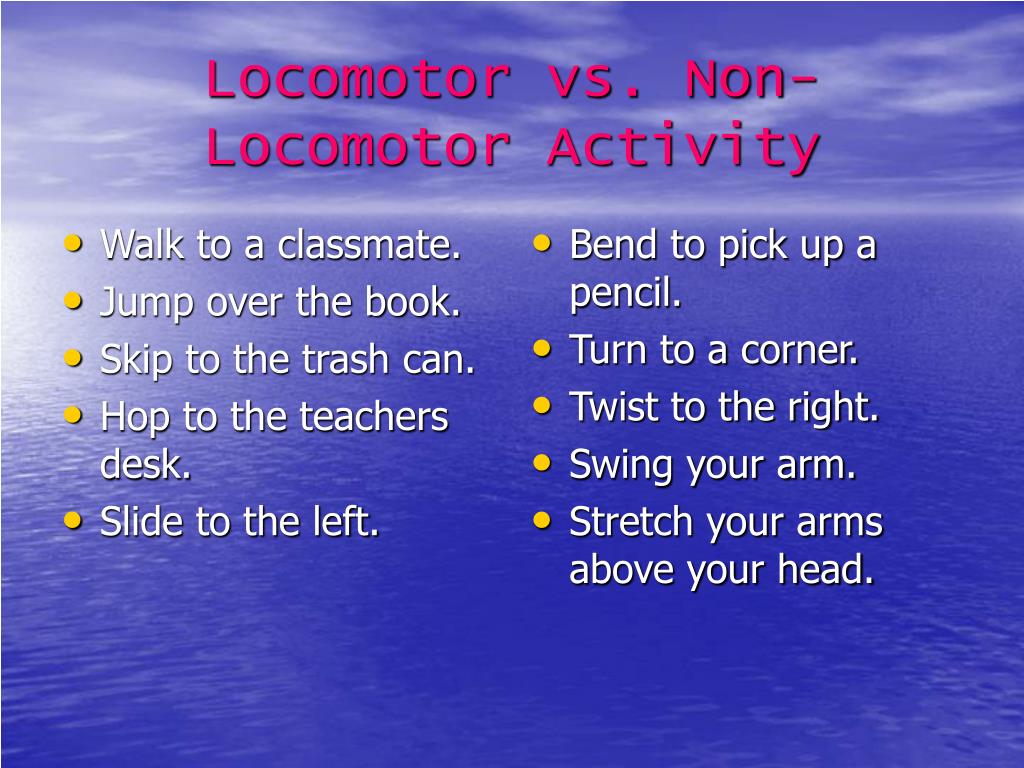What Are Movement Activities Design Talk

Movement Exercises YouTube
Non-Locomotor movement can be defined as movements that occur in the body parts or using the whole body but do not cause the body to travel to another space. In other words, it means "Moving without Moving"!! SHAPE America's Grade Level Outcomes for Non-Locomotor Movement (Elementary)

movements Grade7 YouTube
A non-locomotor skill is a movement performed while remaining stationary, such as stretching, punching, bending, or swaying. Just as locomotor skills are used to function, non-locomotor skills are.

PPT 8 movements 8 movements PowerPoint
non locomotive movement PERFORMANCE OBJECTIVES At the end of this discussion in this unit, students should be able to know about: Meaning of locomotive movement and non-locomotive movement. Examples of Meaning of locomotive movement and non-locomotive movement. TEACHING AND LEARNING MATERIALS Whiteboard/Chalkboard Explanatory posters/pictures

NON MOVEMENT
non-locomotor movement | NCpedia. noun. any movement that does not travel, but uses the available space in any direction or movement organized around the axis of the body (axial movement); bending, twisting, stretching, and swinging are examples of axial movement. What are the examples of locomotor and non-locomotor movements?

skills Physical education activities, Elementary
Non Locomotor movement is a movement in which the body doesn't travel What are the examples of Non Locomotor Movements? 1. Balancing 2. Rotation 3. Bending 4.

POINTING OUT PE Movement capnpetespowerpe
A non-locomotor movement is a movability in which the frame doesn't go; in other words, to can be performed while staying in the same space. Some past include flexing, twisting, and stretching. Locomotor skills, by contrast, were sliding is lid distances, such than running, walking, and leaping.

MOVEMENT VLOG019 YouTube
Welcome to my channel! I'll be explaining the difference between locomotor and non-locomotor movements in this video and provide several examples. Feel free.

Movement Display Banners 10 Large Vertical Banners
Non-locomotor movement development in childhood is important for balance, flexibility, body control, and spatial awareness. Non-locomotor skill development early in life is predictive of.

Movement Top 10 Movement Visuals Simple Large Print
Non-locomotor movement is "movement that moves around the axis of the body (the spine) rather than movement which takes the body through space." Non-locomotor movement is anchored movement. It stays in one place. Basic non-locomotor movements include bend-straighten, twist-turn, swing-rock, push-pull, curl-stretch, and rise-fall.

and movements YouTube
Non-locomotor movements They are anchored, that is, executed around the axis of the body (vertebral column). They occur throughout the body or in parts of it, without there being a trip to another space. The main non-locomotor movements are: Bend It consists in flexing a part of the body.

Movement Top 10 Movement Visuals Simple Large Print Design
As for Non-locomotive movements, they are movements that do not involve traveling from one place to another. There are many examples of non-locomotor movements, which include: Bending Stretching Extending Turning Raising Twisting Rotating

What Are Movement Activities Design Talk
Non-locomotor skills encompass a wide range of movements that do not involve traveling, such as bending, twisting, stretching, balancing, swaying, and turning. These skills primarily focus on body stability, posture, and control.

& Movements YouTube
1. Demonstrate a variety and combinations of non-locomotor skills using a range of body joints and positions. (GCO 1, KSCO 2, 3) ABOUT MOVEMENT 2. Identify non-locomotor skills that contribute to improved health and an active lifestyle. (GCO 2, KSCO 1, 3; GCO 3, KSCO 1) THROUGH MOVEMENT 3.

Movement Printable Display Signs capnpetespowerpe
In today's Physical Education Class class, we will be learning about Non-locomotive Movements Non-locomotive Movements As we have come to learn from our two previous classes, a movement is an act of change in the position or location of something. Movement is the natural way of shifting the body from one place to another. Now try shifting.

movements explained! YouTube
This video is performed and edited by my sister, Bregeth Jamandron. She wanted to share how non-locomotor movements are executed. This video is made as subje.

Movement Top 10 Movement Visuals Simple Large Print
Non-locomotor movements explained! - YouTube 9. Locomotor movements: https://youtu.be/YDHJkBK410cNon-locomotor skills are fundamental body movements that do not incorporate traveling..